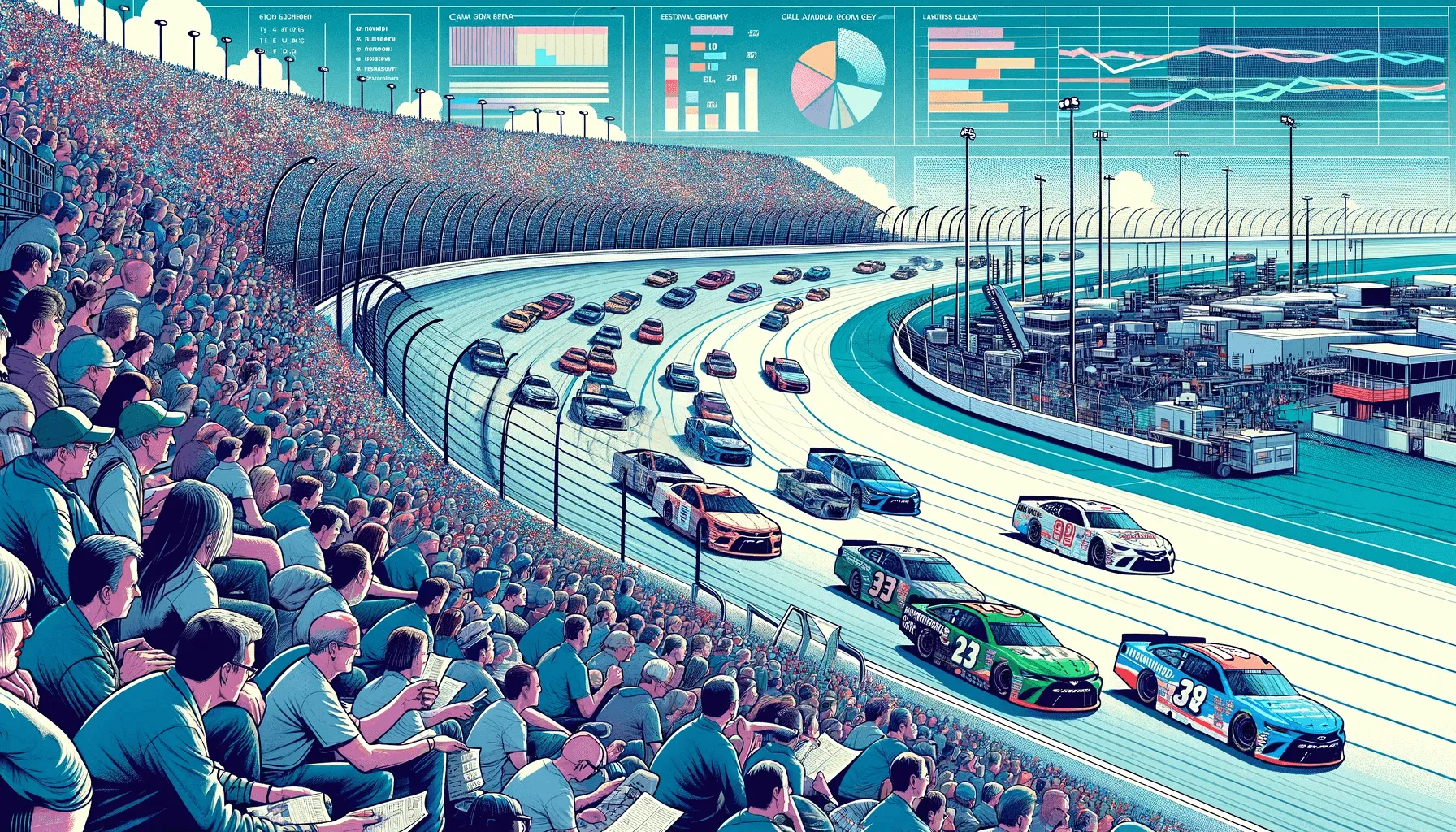NASCAR, or the National Association for Stock Car Auto Racing, is a popular motorsport that has captivated audiences around the world for decades. With its roots in the southern United States, NASCAR has grown into a global phenomenon, with millions of fans tuning in to watch high-speed races on oval tracks.
In this article, we will delve into the rich history of NASCAR and uncover some interesting facts about this beloved sport. From its humble beginnings in the early 20th century to its current status as one of the most-watched sports in America, we will explore how NASCAR has evolved over the years. So buckle up and get ready to take a journey through the ups and downs, triumphs and controversies, and everything else that makes NASCAR such a thrilling and enduring sport.
1. The Origins of NASCAR

The Birth of Stock Car Racing (800 words)
The seeds of NASCAR were sown in the early 1900s, when stock car racing first emerged as a popular form of competition in the United States. Unlike other forms of racing, such as open-wheel racing, where specialized cars were built for the track, stock car racing involved using regular, unmodified cars that were available to the general public. This made it more relatable and accessible to the average person, and it quickly gained popularity among racing enthusiasts.
The first organized stock car race was held at Daytona Beach, Florida in 1903, and it was won by Ransom Olds, the founder of the Oldsmobile brand. However, it wasn’t until the Prohibition era in the 1920s that stock car racing truly took off. During this time, bootleggers used powerful, modified cars to outrun the police and deliver their illegal liquor. These cars were known as “moonshine runners” and their drivers were highly skilled at maneuvering them through narrow, winding roads at high speeds. As the competition among bootleggers intensified, they started to race each other to see who had the fastest car, which eventually led to the birth of organized stock car racing.
The Formation of NASCAR (1000 words)
The National Association for Stock Car Auto Racing was officially formed in 1948 by Bill France Sr., a former moonshine runner and owner of a gas station and repair shop in Daytona Beach. He saw the potential of stock car racing and wanted to bring it under one governing body to make it more organized and legitimate. Along with other promoters and racers, France established NASCAR as a sanctioning body that would oversee the rules and regulations of the sport.
The first official NASCAR race was held on February 15, 1948, at the Daytona Beach Road Course, and it was won by Red Byron driving a Ford. However, it wasn’t long before the newly-formed organization faced some challenges. The first major hurdle came in the form of safety concerns, as the cars used in NASCAR races were not built for high-speed competitions and often lacked proper safety features. This led to several deadly accidents, including the tragic crash of popular driver Glenn “Fireball” Roberts in 1964. As a result, NASCAR introduced several safety measures, such as roll cages and fuel cells, to make the sport safer for drivers.
Another challenge for NASCAR in its early years was gaining mainstream recognition and attracting a larger audience. To achieve this, Bill France Sr. came up with the idea of creating a series of races that would culminate in a championship at the end of the year. This gave birth to the NASCAR Grand National Series, which later became known as the NASCAR Cup Series, and is still the premier racing series in the sport today.
2. The Evolution of NASCAR
From Dirt Tracks to Superspeedways (800 words)
In its early days, NASCAR races were held on dirt tracks, mostly in the southeastern United States. The cars used for these races were still based on regular production models, but they were modified to make them faster and more powerful. As the popularity of stock car racing grew, so did the size and speed of the tracks. In 1959, the first superspeedway, Daytona International Speedway, was opened, which paved the way for bigger and faster tracks like Talladega Superspeedway and Bristol Motor Speedway.
One notable event that helped propel NASCAR into the mainstream was the 1979 Daytona 500, which is often referred to as “the fight that made NASCAR.” In a dramatic finish to the race, Donnie Allison and Cale Yarborough crashed on the final lap, allowing Richard Petty to come out victorious. After the race, Allison and Yarborough got into a physical altercation, which was captured on live TV and broadcasted to millions of viewers. This incident brought national attention to NASCAR, and it was a turning point that helped increase its popularity even further.
The Modern Era of NASCAR (1000 words)
The 1990s marked a significant shift in NASCAR’s evolution, as the sport started to become more commercialized. Sponsors began to play a major role in the success of teams and drivers, with companies like GM Goodwrench, DuPont, and Kellogg’s backing some of the top names in the sport. This led to an influx of money into the sport, which resulted in better equipment, faster cars, and higher purses for winning drivers.
The 2001 season was a dark time for NASCAR, as it saw the tragic deaths of two popular drivers, Dale Earnhardt Sr. and Adam Petty, in separate accidents. These incidents sparked major changes in safety regulations, including the introduction of the HANS device, which helps prevent neck injuries in crashes. This renewed focus on safety has helped make NASCAR one of the safest forms of motorsport today.
In recent years, technology has also played a significant role in the evolution of NASCAR. With the introduction of fuel injection and electronic fuel management systems in 2012, the sport continues to evolve and innovate to stay at the cutting edge of racing technology.
3. The Rules and Regulations of NASCAR

The Points System (800 words)
One of the most important aspects of NASCAR is its points system, which determines the champion at the end of each season. The current system was introduced in 2017 and is commonly referred to as the “Playoff” system. Under this format, drivers earn points based on their finishing positions in each race, with the winner receiving 40 points and the last-place finisher receiving just one point. Additional points are also awarded for leading laps and winning stages during a race.
At the end of the regular season, the top 16 drivers with the most points qualify for the Playoffs. These drivers then compete in a series of elimination rounds, with four drivers being eliminated after each round. The final four drivers compete in the Championship Race, with the highest-placed finisher among them being crowned the champion.
Car Specifications and Restrictions (1000 words)
NASCAR cars are not allowed to be built from scratch; instead, they must be based on production models that are available to the public. The cars are heavily modified to make them faster, safer, and more aerodynamic, but they still retain some key components from the production model.
Among the modifications made to NASCAR cars are reinforced roll cages, fuel cells, and special racing tires. The engines are also highly tuned, producing over 850 horsepower, making them significantly more powerful than their stock counterparts. However, there are several restrictions in place to ensure fair competition among drivers. For instance, each car must weigh a minimum of 3,300 pounds, and all engines must be naturally aspirated.
Another key aspect of NASCAR is its strict regulations on aerodynamics and body modifications. The cars must have a specific body template, which includes the shape of the roof, front fenders, and rear quarter panels. This ensures that all cars are as similar as possible in terms of aerodynamics, giving no team an unfair advantage over the others.
4. Interesting Facts about NASCAR
The Record Holders (800 words)
Over the years, many drivers and teams have made their mark in NASCAR history by setting records that continue to stand to this day. Some notable record holders include Richard Petty, who has the most wins in NASCAR Cup Series history with 200 victories, and Jimmie Johnson, who holds the record for most consecutive championships with five in a row from 2006 to 2010.
Other records in NASCAR include the most poles in a season, which was set by Cale Yarborough in 1980 with 14, and the most consecutive starts without a DNF (Did Not Finish), which belongs to Jeff Gordon with 797. It’s also worth mentioning the record for the oldest driver to win a race, which is held by Harry Gant, who was 52 years old when he won the Pop Secret Microwave Popcorn 400 in 1992.
The First Female Driver (1000 words)
NASCAR has traditionally been a male-dominated sport, but that hasn’t stopped women from making their mark in the sport. The first female driver to compete in a NASCAR premier series race was Louise Smith, who raced in the inaugural Southern 500 in 1949. However, it wasn’t until the 1970s that women started to gain more recognition in the sport.
Janet Guthrie became the first woman to qualify for the Daytona 500 in 1977, and she went on to compete in 33 NASCAR Cup Series races throughout her career. In 2013, Danica Patrick made history by becoming the first woman to win the pole position for the Daytona 500, and she also holds the record for the highest finish by a female driver in the race with an eighth-place finish in 2013.
5. Controversies in NASCAR

Cheating Scandals (800 words)
Like any other sport, NASCAR has had its fair share of controversies and scandals over the years. One of the most common forms of cheating in NASCAR is altering the car’s aerodynamics to give it an unfair advantage on the track. This can be achieved through various methods, such as using illegal parts, tampering with the engine, or manipulating the car’s body.
In 1990, four drivers were caught with illegally altered engines at the Daytona 500, which led to significant penalties for their teams. More recently, in 2007, Michael Waltrip’s team was found to have used a substance called jet fuel in their car’s fuel mixture, resulting in severe penalties and suspensions for the team members involved.
Disqualifications and Appeals (1000 words)
Another controversial aspect of NASCAR is its appeals process, which allows teams to challenge penalties imposed by NASCAR officials. This process has been subject to criticism over the years, with some teams feeling that the appeals process is biased towards bigger teams and more popular drivers.
One notable incident occurred in 2019 when Denny Hamlin won the Daytona 500, but his car failed the post-race inspection due to an issue with the rear spoiler. As a result, he was disqualified, and the victory was awarded to Joe Gibbs Racing teammate Kyle Busch. However, Hamlin’s team successfully appealed the penalty, and the win was reinstated a few days later.
6. The Future of NASCAR
Embracing Diversity (800 words)
In recent years, NASCAR has made a concerted effort to embrace diversity and reach out to a broader audience. This includes initiatives such as the Drive for Diversity program, which aims to identify and develop talented drivers from diverse backgrounds. Over the years, this program has helped launch the careers of several drivers, including Kyle Larson and Bubba Wallace.
NASCAR has also taken steps to promote gender equality in the sport by launching programs like the Women in the Winner’s Circle Foundation and partnering with organizations like Girls Inc. to encourage young girls to pursue careers in motorsports.
Adapting to New Technology (1000 words)
As technology continues to evolve, so does the world of motorsports, and NASCAR is no exception. One significant change that is expected to take place in the near future is the introduction of hybrid engines in NASCAR cars. This will not only make the cars more efficient and environmentally friendly but also add a new layer of strategy to the races.
Another area where NASCAR is looking to modernize is through its digital presence. The sport is heavily reliant on TV viewership for revenue, but with the rise of streaming services and online platforms, NASCAR is exploring ways to engage with fans and grow its audience through social media and other digital channels.
Conclusion: Moving Full Speed Ahead
In conclusion, NASCAR has come a long way from its humble beginnings as a form of illegal street racing. Today, it is a multi-billion dollar industry that showcases some of the best drivers, teams, and technology in the world. While it has had its fair share of challenges and controversies, NASCAR continues to attract millions of fans and remains one of the most beloved and exciting sports around. With its rich history, passionate fan base, and continuous evolution, it’s safe to say that NASCAR is here to stay, and we can’t wait to see what the future holds for this thrilling motorsport.


